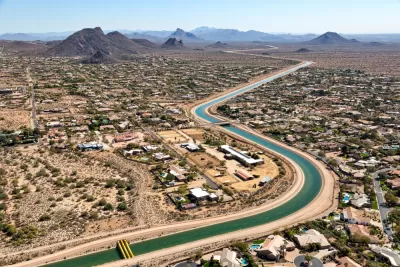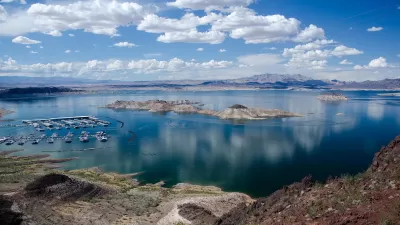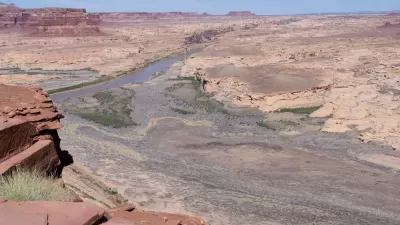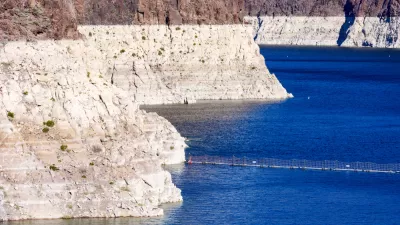Even as more people and companies flock to the state for its climate and economic opportunities, Arizona's water supplies are facing historic shortages.

"Arizona’s annual gross domestic product, nearing $380 billion, has more than doubled since 2000. New solar installations, electric vehicle makers, computer chip manufacturers, data centers, and corporate farming companies are piling into the state." Meanwhile, Phoenix is now the fifth largest city in the country. But as Keith Schneider writes, the state's booming growth is threatened by strained water supplies and dire projections for the future.
Climate change is disrupting the rules of the development game. Drought and extreme heat are emptying rivers and reservoirs, fallowing tens of thousands of acres of farmland, forcing thousands of homeowners to secure water from trucks and not their dead wells, and pushing Arizona ever closer to the precipice of peril.
The Colorado River, which provides over a third of the state's water supply, is 20 percent lower now than two decades ago. And, as we have covered in Planetizen previously, the two largest reservoirs in the country, Lake Mead and Lake Powell, both bordering Arizona, "now hold less water than at any time since soon after they were opened" at 30 percent capacity.
According to the article, the state is starting to take a harder look at ways to reduce its water usage and conserve for the future, but housing construction continues even as Arizona farmers face water shortages, some forced to reduce the amount of crops they grow.
FULL STORY: At Peak of Its Wealth and Influence, Arizona’s Desert Civilization Confronts A Reckoning Over Water

Alabama: Trump Terminates Settlements for Black Communities Harmed By Raw Sewage
Trump deemed the landmark civil rights agreement “illegal DEI and environmental justice policy.”

Study: Maui’s Plan to Convert Vacation Rentals to Long-Term Housing Could Cause Nearly $1 Billion Economic Loss
The plan would reduce visitor accommodation by 25% resulting in 1,900 jobs lost.

Why Should We Subsidize Public Transportation?
Many public transit agencies face financial stress due to rising costs, declining fare revenue, and declining subsidies. Transit advocates must provide a strong business case for increasing public transit funding.

Paris Bike Boom Leads to Steep Drop in Air Pollution
The French city’s air quality has improved dramatically in the past 20 years, coinciding with a growth in cycling.

Why Housing Costs More to Build in California Than in Texas
Hard costs like labor and materials combined with ‘soft’ costs such as permitting make building in the San Francisco Bay Area almost three times as costly as in Texas cities.

San Diego County Sees a Rise in Urban Coyotes
San Diego County experiences a rise in urban coyotes, as sightings become prevalent throughout its urban neighbourhoods and surrounding areas.
Urban Design for Planners 1: Software Tools
This six-course series explores essential urban design concepts using open source software and equips planners with the tools they need to participate fully in the urban design process.
Planning for Universal Design
Learn the tools for implementing Universal Design in planning regulations.
Smith Gee Studio
Alamo Area Metropolitan Planning Organization
City of Santa Clarita
Institute for Housing and Urban Development Studies (IHS)
City of Grandview
Harvard GSD Executive Education
Toledo-Lucas County Plan Commissions
Salt Lake City
NYU Wagner Graduate School of Public Service





























